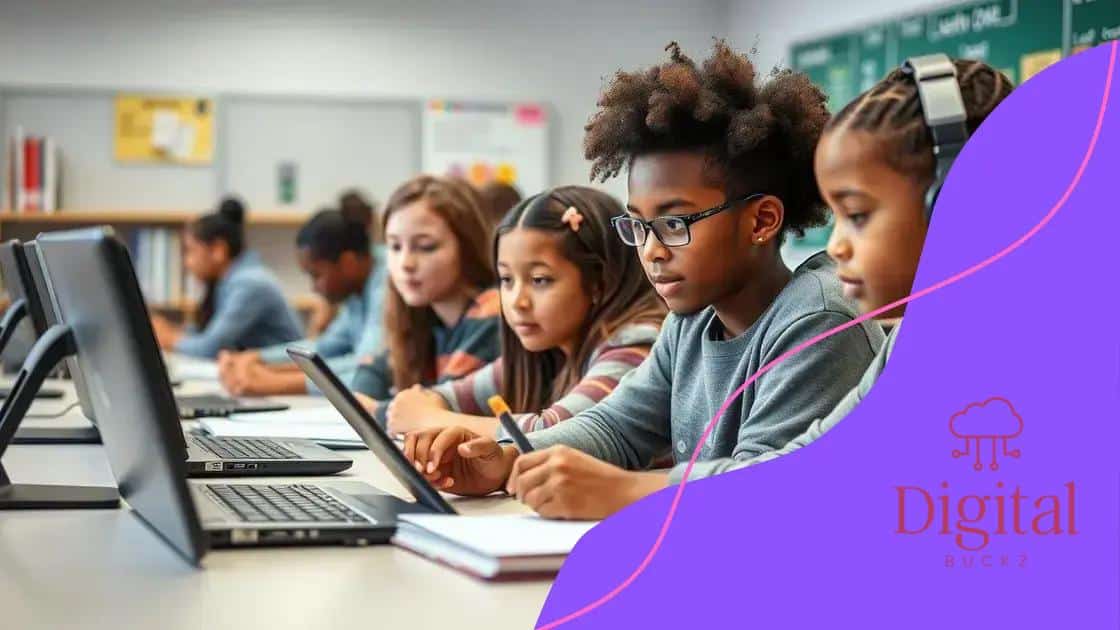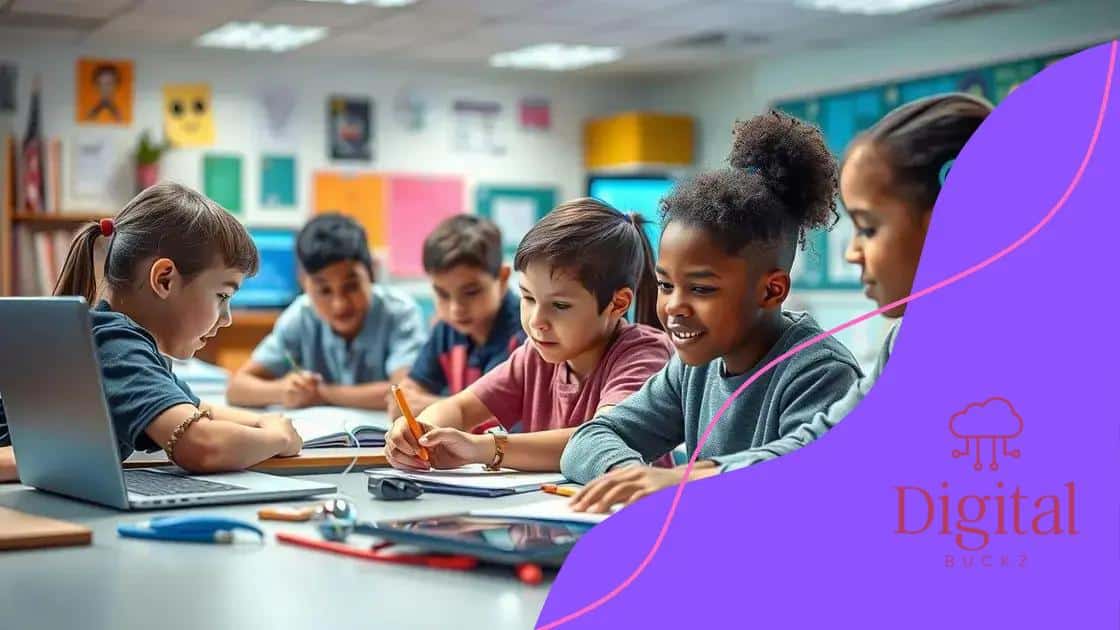The role of AI in creating personalized learning experiences

The role of AI in creating personalized learning experiences enhances education by tailoring content and teaching methods to meet each student’s unique needs, improving engagement and outcomes.
The role of AI in creating personalized learning experiences is reshaping the educational landscape. Imagine a classroom where every student learns at their own pace and style. Intrigued? Let’s delve deeper.
Understanding personalized learning
Understanding personalized learning is crucial in today’s educational landscape. It involves tailoring the learning experience to fit the unique needs of each student. Imagine a classroom where lessons adapt based on students’ strengths and weaknesses, making learning more effective.
At the heart of this approach is flexibility. Students learn at their own pace and choose subjects that interest them. This method can drastically improve motivation and engagement, leading to better educational outcomes.
Key Benefits of Personalized Learning
Personalized learning offers several advantages:
- Increased engagement: Students are more likely to participate when lessons are relevant to them.
- Tailored instruction: Teachers can focus on individual strengths and address weaknesses effectively.
- Improved retention: Custom learning paths help students remember information better.
- Empowered learners: Students take ownership of their education, leading to higher satisfaction.
Moreover, technology plays a significant role in making personalized learning possible. Tools like learning management systems and adaptive learning software provide real-time data. This information helps educators make informed decisions about instructional strategies, enriching the learning environment.
Some key aspects to consider include student choice and feedback. When students can select their paths, they feel more invested in their learning. Continuous feedback ensures that they are progressing and making adjustments as needed. Adopting a culture of feedback creates a more dynamic learning experience.
Overall, the understanding of personalized learning highlights its importance in fostering educational success. By adapting teaching methods to student needs, we can create a more inclusive and effective learning environment for everyone.
How AI adapts to individual learning styles
How AI adapts to individual learning styles is a fascinating topic. With advancements in technology, educators can now personalize the learning experience for each student. This makes learning more engaging and effective.
AI uses data analytics to understand how different students learn. By examining factors like speed and comprehension, it tailors educational content to fit individual needs. This personalization encourages students to thrive in ways that traditional methods may not.
Different Learning Styles Supported by AI
AI can cater to various learning styles:
- Visual learners: They benefit from diagrams, charts, and videos that illustrate concepts.
- Auditory learners: These students grasp information best through podcasts, discussions, and audio content.
- Kinesthetic learners: They thrive in hands-on activities, using simulations and interactive tools to learn.
- Reading/writing learners: They respond well to text-based materials, such as articles or e-books.
Integrating multiple styles creates an inclusive environment. AI-powered platforms can analyze student interactions and adjust content dynamically. As a result, students engage with materials that resonate with them personally.
Moreover, adaptive learning platforms track progress in real-time. They offer instant feedback, which is crucial in a personalized learning model. This timely information helps students understand their strengths and areas for improvement.
Additionally, AI encourages a growth mindset by providing customized challenges. When students face tasks suited to their ability level, they build confidence while progressing in their skills. AI’s role in refining lessons ensures better outcomes for each learner.
The impact of AI on student engagement

The impact of AI on student engagement is significant and transformative. With personalized learning experiences, AI can capture students’ attention in meaningful ways. By using tailored content and adaptive technologies, educators can create a more captivating learning environment.
AI tools analyze student performance in real-time. This analysis allows teachers to adjust their strategies based on individual progress. When students feel that their unique needs are met, they are more likely to participate actively and stay motivated.
Ways AI Enhances Engagement
There are several ways that AI enhances student engagement:
- Interactive learning: AI encourages activities that foster participation, such as quizzes and games that make learning fun.
- Immediate feedback: Students receive real-time responses to their answers, keeping them informed about their understanding of the material.
- Personalized content: Materials are adjusted to match interests and skill levels, making lessons more relevant.
- Gamification: AI incorporates game elements that motivate students to complete tasks and achieve goals.
Furthermore, the use of AI can lead to deeper connections among students. Collaborative platforms enable group work where students communicate and share ideas effectively. This interaction helps build a community of learners who support each other.
Teachers also benefit from AI tools, as they gather insights on student needs and preferences. By focusing on engagement strategies that work, educators can refine their teaching methods and bolster student interest.
Ultimately, the impact of AI on student engagement illustrates how technology can enhance learning experiences. By leveraging AI, schools can foster more passionate and involved learners, shaping a brighter future for education.
Challenges in implementing AI in education
Implementing AI in education poses several challenges that educators must navigate. While the potential benefits are significant, obstacles often arise during integration. Understanding these challenges is crucial for successful implementation.
One major hurdle is the lack of resources and training. Many educators feel unprepared to use AI technology in their classrooms. Providing adequate training and professional development is essential for teachers to feel confident.
Common Challenges Faced
Here are some common challenges in implementing AI:
- Resistance to change: Some educators may prefer traditional teaching methods and resist adopting new technologies.
- Data privacy concerns: With AI systems collecting data, there can be worries about how that information is used and protected.
- Cost of technology: Implementing AI tools often requires significant investment, which can be a barrier for many schools.
- Equity issues: Not all students have equal access to technology, leading to disparities in learning opportunities.
Additionally, integrating AI into existing curricula can be complex. Curriculum changes require careful planning to ensure that technology supports educational goals instead of distracting from them. Educators must balance innovative methods with established practices to maintain instructional quality.
Moreover, continuous updates to AI technology can pose another challenge. As tools evolve, schools must keep up with new developments. This can feel overwhelming for educators who already face numerous responsibilities.
Despite these challenges, steps can be taken to overcome obstacles. Engaging all stakeholders, including teachers and parents, can help build a supportive community. With careful planning and collaboration, schools can successfully integrate AI in education, benefiting both teachers and students.
Future trends in AI-driven learning
Future trends in AI-driven learning are exciting and full of potential. As technology evolves, so does the way we educate students. The integration of AI in learning is transforming education by providing innovative tools and approaches.
One significant trend is the rise of personalized learning experiences. Educators will use AI to create tailored lesson plans based on individual student needs. This can improve engagement and ensure students grasp concepts at their own pace.
Predicted Trends in AI Learning
Here are some predicted trends for the future:
- Adaptive learning technologies: These tools will continue to evolve, providing more real-time feedback and customized learning paths.
- Increased use of virtual reality (VR): VR will offer immersive learning experiences that enable students to explore subjects in new ways.
- Enhanced analytics: Advanced data analytics will help track student performance and refine teaching methods based on solid evidence.
- Collaboration with AI tutors: Students may increasingly work alongside AI tutors that offer assistance and clarification.
Moreover, the utilization of gamification will grow in classrooms. By making learning fun and interactive, educators can motivate students to engage more deeply with their studies. Games and challenges can create a stimulating environment, improving overall learning outcomes.
Another emerging concept is the development of social learning networks powered by AI. These platforms will connect students from around the world, allowing them to collaborate on projects and share knowledge. This global interaction can enrich learning experiences and foster cultural awareness.
Evolving technology will additionally lead to greater emphasis on skills like critical thinking and problem-solving. AI-driven tools will encourage students to think creatively and address challenges in innovative ways, preparing them for future careers.
In conclusion, the future of AI-driven learning holds great promise for transforming education. Personalized learning experiences, enhanced engagement through innovative technologies, and the potential for global collaboration will shape how students learn. Despite challenges in implementation, the ongoing advancements in AI provide exciting opportunities for educators and students alike. As we embrace these changes, the goal remains clear: to create an inclusive, engaging, and effective learning environment that empowers every student to succeed.
FAQ – Frequently Asked Questions about AI in Education
What is AI-driven learning?
AI-driven learning uses artificial intelligence technologies to create personalized educational experiences, adapting to each student’s unique needs.
How does AI improve student engagement?
AI enhances student engagement by providing interactive tools, real-time feedback, and personalized content that keeps students motivated and involved.
What are some challenges of implementing AI in education?
Challenges include resistance to change, data privacy concerns, cost of technology, and ensuring equity in access to resources.
What future trends can we expect in AI-driven learning?
Future trends include more personalized learning experiences, increased use of virtual reality, enhanced analytics, and greater global collaboration.






